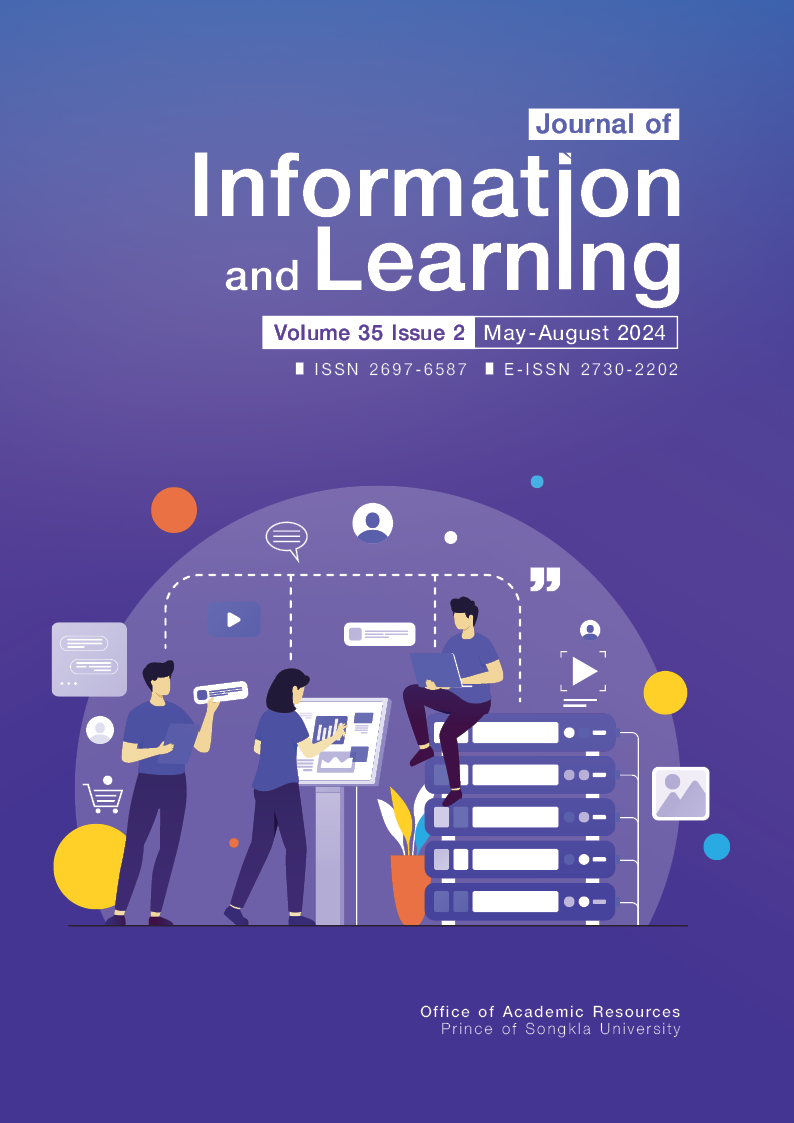การวินิจฉัยแบบองค์รวมและแบบแยกองค์ประกอบของทักษะการแก้โจทย์ปัญหาทางคณิตศาสตร์และทักษะการเชื่อมโยงในชีวิตจริงของนักเรียนระดับประถมศึกษา จังหวัดปัตตานี
Main Article Content
บทคัดย่อ
การวิจัยครั้งนี้มีวัตถุประสงค์ 1) เพื่อวินิจฉัยทักษะการแก้โจทย์ปัญหาคณิตศาสตร์แบบองค์รวมและแบบแยกองค์ประกอบสำหรับนักเรียนระดับประถมศึกษา จังหวัดปัตตานี 2) เพื่อวินิจฉัยทักษะการเชื่อมโยงในชีวิตจริงแบบองค์รวมและแบบแยกองค์ประกอบสำหรับนักเรียนระดับประถมศึกษา จังหวัดปัตตานี กลุ่มเป้าหมายที่ใช้ในการวิจัย 1) ครูผู้สอนคณิตศาสตร์ชั้นประถมศึกษาปีที่ 5-6 จำนวน 11 คน ได้มาโดยการเลือกแบบเจาะจง 2) นักเรียนชั้นประถมศึกษาปีที่ 5-6 ภาคเรียนที่ 2 ปีการศึกษา 2566 จำนวน 463 คน เครื่องมือที่ใช้ในการวิจัย คือ 1) แบบสัมภาษณ์สำรวจข้อบกพร่อง เรื่องโจทย์ปัญหาเศษส่วน 2) แบบทดสอบวินิจฉัยทักษะการแก้โจทย์ปัญหาคณิตศาสตร์และแบบทดสอบวินิจฉัยทักษะการเชื่อมโยงในชีวิตจริง สถิติที่ใช้ในการวิจัย ได้แก่ ร้อยละ ค่าเฉลี่ย ส่วนเบี่ยงเบนมาตรฐาน
ผลการวิจัยพบว่า 1) การวินิจฉัยทักษะการแก้โจทย์ปัญหาของนักเรียนชั้นประถมศึกษาปีที่ 5-6 พบว่า ข้อบกพร่องของทักษะการแก้โจทย์ปัญหาคณิตศาสตร์ คือ นักเรียนเข้าใจโจทย์แต่ตีความโจทย์ปัญหาผิด ขาดทักษะในการคิดคำนวณและไม่สรุปคำตอบ ผลการวินิจฉัยในภาพรวมอยู่ในระดับดี โดยองค์ประกอบการทำความเข้าใจปัญหา การวางแผนการแก้ปัญหา และการสรุปคำตอบอยู่ในระดับดี และการดำเนินการแก้ปัญหาอยู่ในระดับพอใช้ 2) การวินิจฉัยทักษะการเชื่อมโยงในชีวิตจริงของนักเรียนชั้นประถมศึกษาปีที่ 5-6 พบว่า ข้อบกพร่องของทักษะการเชื่อมโยงในชีวิตจริง คือ นักเรียนไม่เข้าใจเนื้อหาเศษส่วนจึงนำไปเชื่อมโยงปัญหาได้ ขาดความเข้าใจในสาระวิชาอื่น ผลการวินิจฉัยในภาพรวมอยู่ในระดับดี โดยองค์ประกอบการเชื่อมโยงเรื่องต่าง ๆ ของคณิตศาสตร์ การเชื่อมโยงคณิตศาสตร์ในชีวิตประจำวันอยู่ในระดับดี และการเชื่อมโยงคณิตศาสตร์กับสาระวิชาอื่นอยู่ในระดับพอใช้
Article Details

อนุญาตภายใต้เงื่อนไข Creative Commons Attribution-NonCommercial-NoDerivatives 4.0 International License.
Journal of Information and Learning ดำเนินการโดยสำนักวิทยบริการ มหาวิทยาลัยสงขลานครินทร์ วิทยาเขตปัตตานี บทความที่ได้รับการตีพิมพ์ในวารสารได้รับความคุ้มครองตามกฎหมายลิขสิทธิ์ โดยเจ้าของลิขสิทธิ์จะมีสิทธิในการทำซ้ำ ดัดแปลง และเผยแพร่งานบทความ ทั้งรูปแบบอิเล็กทรอนิกส์ การทำฉบับสำเนา การแปล และการผลิตซ้ำในรูปแบบต่างๆ ลิขสิทธิ์บทความเป็นของผู้เขียนและสำนักวิทยบริการ มหาวิทยาลัยสงขลานครินทร์ วิทยาเขตปัตตานี วารสารฯ ขอสงวนสิทธิ์ในการพิจารณาตีพิมพ์ตามความเหมาะสม รวมทั้งการตรวจทานแก้ไข การปรับข้อความ หรือขัดเกลาภาษาให้ถูกต้องตามเกณฑ์ที่กำหนด สำหรับผลการวิจัยและความคิดเห็นที่ปรากฏในบทความถือเป็นความคิดเห็นและอยู่ในความรับผิดชอบของผู้เขียน
เอกสารอ้างอิง
Chuchuaysuwan, A. (2009). Development of a test to measure mathematical connection ability for students Mathayom 5 [Master’s thesis, Srinakharinwirot University]. SWU IR. http://thesis.swu.ac.th/swuthesis/Ed_Mea/Atchanee_C.pdf
Tenghiran, P., Hadkaew, P., & Yamsang, N. (2018). A study of mathematical deficiencies on fractions of 4th grade students Muslim Santitham Foundation School. Graduate Journal Faculty of Education, 2(2), 1-10. http://www.edu-journal.ru.ac.th/index.php/abstractData/viewIndex/2234.ru
Dossey. (2002). Mathematics methods and modeling for today’s mathematics classroom: A contemporary approach to teaching grades 7-12. Brooks/Cole.
Institute for the Promotion of Teaching Science and Technology. (2012). kān watphon pramœ̄nphon khanittasāt [Mathematics Assessment and Evaluation]. Se-Education.
Institute for the Promotion of Teaching Science and Technology. (2018). Thaksa læ krabūankān thāng khanittasāt [Mathematics skills and processes] (3rd ed., amended). https://www.ipst.ac.th/curriculum
Ismail, M. B. (1995). Development and validation of a multicomponent diagnostic test of arithmetic word problem solving ability for six-grade student in Malaysia. University of Pittsburgh. https://books.google.co.th/books?id=HYJnnQAACAAJ
Jairuen, J. (2017). Teaching practices to promote mathematical connection skills of students. Mathayom 5 [Master’s Thesis, Chiang Mai University]. Chiang Mai University Digital Collections. https://cmudc.library.cmu.ac.th/frontend/Info/item/dc:125960
Ketterlin-Geller, L. R., & Yovanaoff, P. (2009) “Diagnostic assessments in mathematics to support instructional dicision making. Practical Assessment, Research & Evaluation, 14(16). https://scholarworks.umass.edu/cgi/viewcontent.cgi?article=1222&context=pare
Khamrat, N. (2022). The effect of learning management according to Polya’s problem solving process with Bar Model Techniques towards problem solving ability and attitudes towards mathematics learning of Matthayomsuksa 2 students. Social Science Reserch and Academic Journal, 17(2), 213-226. https://so05.tci-thaijo.org/index.php/JSSRA/article/view/253737
Ministry of Education. (2008). Basic education core curriculum 2008. Teachers Council Printing House.
National Institute of Educational Testing Service. (2022). Sarup phon kānthotsō̜p thāngkān sưksā radap chāt naphư̄n thān (O-NET) chan prathom sưksā pī thī hok pīkānsưksā sō̜ngphanhārō̜ihoksiphā [Summary of results of basic national educational testing (O-NET), Grade 6, academic year 2022]. NIETS. https://www.niets.or.th/th/content/view/25618
Ruamsuk, C. (2017). Development of mathematical connection skills and mathematical problem-solving skills through inquiry-based learning combined with project-based learning [Master’s thesis, Ubon Ratchathani University]. Ubon Ratchathani University Portal site for E-Thesis & E-Research. https://www.esanpedia.oar.ubu.ac.th/e-research/sites/default/files/Chalermkwan_Ruamsuk.pdf
Suryono, W., Suyitno, H., & Junaedi, I. (2020). Mathematical connection ability and students’ independence in Missouri Mathematics Project e-Learning. Unnes Journal of Mathematics Education Research, 9(2), 185-189. https://journal.unnes.ac.id/sju/ujmer/article/view/33307


